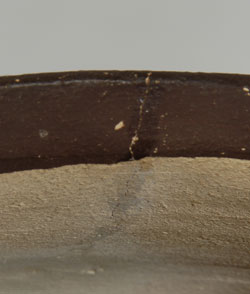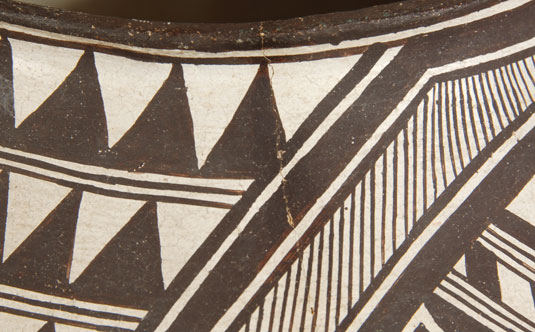Zuni Polychrome Jar Attributed to Tsayutitsa [SOLD]
+ Add to my watchlist Forward to Friend
- Category: Historic
- Origin: Zuni Pueblo, SHE-WE-NA
- Medium: clay, pigment
- Size: 11-1/4” height x 13-1/4” diameter
- Item # C3888A SOLD
Zuni Pueblo potters, except for a few, have never been appreciated for outstanding application of design, unlike their closest neighbors, the Acoma potters. Zuni clay is more porous than that at Acoma and more difficult to obtain a smooth egg-shell hard surface on which to paint designs. The slip used does not appear to respond to a hard burnish, leaving a poorer surface on which to paint.
It is recognized that, by 1920, there were only a dozen good potters at Zuni making excellent pottery. Most other potters had been convinced by the new trader, C. G. Wallace, who opened a trading post at the pueblo in 1918, to make small beaded items. He was reluctant to ship pottery so this was his solution. He was purchasing over 600 beaded items daily at one point. Pottery production suffered seriously because of Wallace’s actions.
Of the dozen or so good potters who were still making exceptional wares, only two were recognized as the best and those two had their names recorded along with acquisitions of their work—something not done with the other potters. That these two were recognized for their quality product is an indication of their talent.

These two potters have been revealed through significant research by Jonathan Batkin, without which their fame would not be known today. They were Tsayutitsa (ca.1871-1959) and Catalina Zunie (ca.1862-1949). Of Tsayutitsa, Batkin stated “the great master was Tsayutitsa. She is the best potter of the twentieth century.” (Batkin, 1987). Another quote “the pottery made by Tsayutitsa includes some of the most spectacular jars ever made at the pueblo.” (Lanman & Harlow, 2008)
There was a jar in the Gallegos Collection which Francis Harlow dated circa 1900, which features the identical designs seen on the jar presented here. The two jars—the Gallegos Collection jar and this jar—could not be more similar in design. Interestingly, and explainable, is the fact that there are no jars in the Smithsonian or American Museum of Natural History or other pre-1890 expedition collections with this design, a good indication that this design developed after 1890.
The jar featured in this presentation, and the one in the Gallegos Collection, were unquestionably made by Tsayutitsa, and circa 1900 to 1920 is a good estimate of their date. This design has been identified as her work.
The jar is globular in shape and has a black bottom with a distinctive puki line. The tip of the rim rolls out gracefully. The black unpolished band below the rim on the interior of the neck is traditional to the period. The fine line elements are outlined in a heavy black band surrounding a thinner black band. The application of the painted design was perfect. Each line was drawn to precision and each element filled in with consistent brush strokes. The jar is strikingly beautiful.
Condition: one hairline crack at the rim that has been stabilized
Provenance: from a family in New York, which acquired it over 30 years ago, from Four Winds Gallery in Pittsburgh. A note by the gallery makes an attribution to Tsayutitsa.
References:
- Batkin, Jonathan. Pottery of the Pueblos of New Mexico 1700-1940. The Taylor Museum of the Colorado Springs Fine Arts Center, 1987
- Lanmon, Dwight P. and Francis H. Harlow. The Pottery of Zuni Pueblo. Museum of New Mexico Press, 2008

- Category: Historic
- Origin: Zuni Pueblo, SHE-WE-NA
- Medium: clay, pigment
- Size: 11-1/4” height x 13-1/4” diameter
- Item # C3888A SOLD



